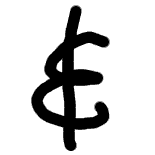ampersand
English
Etymology

A mondegreen of "and per se and", meaning "and (the character) '&' by itself", which is how the symbol (&) was originally referred to in English. This formulation is due to the fact that in schools, when reciting the alphabet, any letter that could also be used as a word in itself ("A," "I," "O" and, at one point, "&") was preceded by the Latin expression per se (Latin for "by itself"). Also, it was common practice to add at the end of the alphabet the "&" sign, pronounced "and". Thus the end of the recitation would be: "X, Y, Z and per se and." This last phrase eventually became "ampersand", and the term crept into common English usage by around 1837.
Pronunciation
- (UK) IPA(key): /ˈæm.pə(ɹ).sænd/, /ˈæmp.ə(ɹ)ˌzænd/
Audio (US) (file)
Noun
ampersand (plural ampersands)
- The symbol "&".
- The ampersand character in many logics acts as an operator connecting two propositions.
Translations
|
|
Verb
ampersand (third-person singular simple present ampersands, present participle ampersanding, simple past and past participle ampersanded)
- (transitive, rare) To add an ampersand to.
Gallery
- Handwritten styles


Further reading
Typography